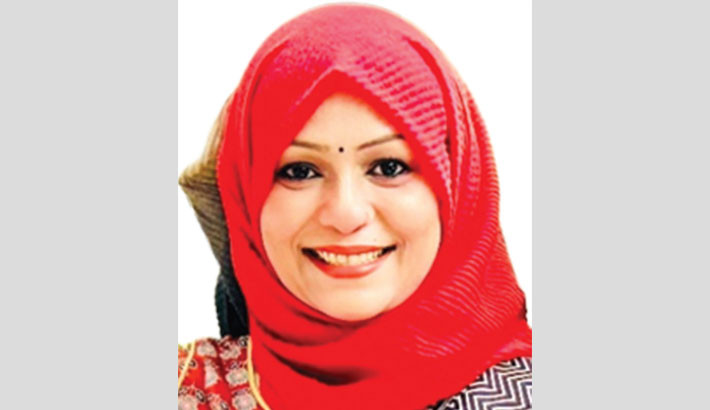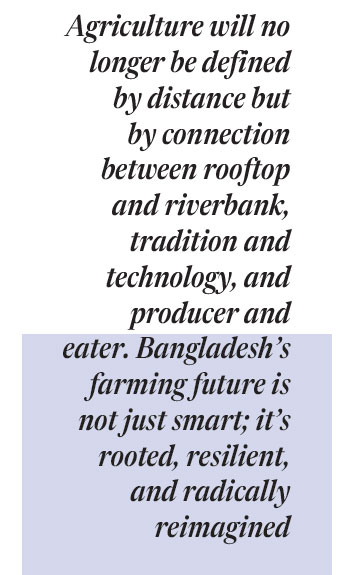Urban Agriculture and Bangladesh’s Journey towards Food Security 2041
Published: 26 Oct 2025

DR SHAHRINA AKHTAR
In 1971, Bangladesh’s founding dream was not only independence but also dignity, the ability to feed its own people. Fifty years later, the story of food is still central to the nation’s survival and sovereignty. Yet as the country prepares to cross the milestone of “Smart Bangladesh 2041”, the notion of farming itself is being rewritten. The future of Bangladesh’s food security is no longer confined to the endless paddy fields of the delta; it is sprouting from rooftops, warehouses, water surfaces, and vertical towers in cities.
The transformation is not merely aesthetic; it is existential. With cultivable land shrinking, climate volatility intensifying, and urbanisation accelerating, Bangladesh’s agricultural resilience depends on how innovatively it can grow food within its cities. From hydroponics and aquaponics to floating gardens and AI-driven farms, a quiet revolution is under way that could redefine the “farm-to-fork” narrative.
Vanishing Fields, Rising Risks: According to the Bangladesh Bureau of Statistics (BBS), the country has already lost nearly 2.5 million hectares of cultivable land since 1980, much of it to unplanned urbanisation, industrial expansion, and infrastructure. The Department of Agricultural Extension (DAE) warns that 8,750 hectares are being lost each year, an area equivalent to 12,000 football fields disappearing annually.
By 2041, arable land could shrink below 6.8 million hectares, down from 8.5 million in 2020. Yet the demand for food is expected to rise by 35-40%, driven by population growth, rising incomes, and shifting diets.
Climate change compounds the challenge. The Bangladesh Delta Plan 2100 predicts that nearly 17% of coastal land could become too saline for traditional rice by 2050. The Intergovernmental Panel on Climate Change (IPCC) identifies Bangladesh as one of the most climate-vulnerable nations on earth, with increased risks of drought in the northwest, flooding in central regions, and cyclonic inundations in the south.
The result is a dual squeeze: less land to farm and harsher conditions for what remains. If the country is to maintain self-sufficiency and ensure safe, nutritious food for its people, it must reinvent both the geography and the technology of food production.
City Farming Future: What once seemed a utopian idea, farming inside cities, has become a pragmatic national strategy. Bangladesh’s urban agriculture boom is transforming rooftops, backyards, water bodies, and abandoned lots into productive ecosystems.
A 2024 study by Sher-e-Bangla Agricultural University found that 93.5% of surveyed urban households in Dhaka, Chattogram, and Rajshahi were engaged in some form of rooftop or container gardening. The trend intensified during the COVID-19 pandemic and has continued, driven by food safety concerns and environmental awareness.
Urban agriculture contributes not only fresh produce but also cooler microclimates, reduced waste, and stronger community bonds. Small-scale hydroponic farms on rooftops or balconies now supply local grocery shops with leafy greens grown without pesticides or soil. With proper nutrient monitoring and water recycling, hydroponics can use up to 90% less water than traditional farming, which is critical for a country that faces recurring droughts in its northern regions.
Vertical farming, another frontier of innovation, is also emerging as a solution to land scarcity. Using controlled environments with LED lighting, precise nutrient control, and artificial intelligence (AI), vertical farms can yield up to 15 times more vegetables per square metre compared to open fields.
The vision for 2041 is clear: every city becomes a mosaic of green, food-producing units, with each household, school, and office rooftop contributing to national food resilience.
New Geography of Growth: While Bangladesh’s arable land continues to shrink due to urban sprawl, salinity, and river erosion, a quiet revolution is taking root in its cities. Rooftops are turning green, balconies are growing basil, and warehouses are humming with vertical farms lit by LEDs. Urban agriculture is no longer an experiment; it is emerging as a strategic pillar of national food security.

A new projection prepared for this report estimates that by 2041, Bangladesh could host more than half a million urban farming hubs, combining floating gardens, vertical farms, and community-based production clusters across its eight divisions. The data reveal how the geography of food is changing, from rice fields to city skylines.
Projected expansion of floating gardens and vertical farms across Bangladesh’s eight divisions, reflecting the rapid growth of city-based food production systems. Dhaka and Chattogram are expected to lead the transformation, followed closely by Barishal and Khulna, signalling a decisive shift toward climate-resilient urban agriculture.
AgriTech Revolution: The fourth agricultural revolution in Bangladesh is built not only on soil and water but also on data. Artificial intelligence, drones, and Internet of Things (IoT) systems are reshaping how food is grown, monitored, and marketed.
IoT sensors in hydroponic systems now measure pH, temperature, electrical conductivity (EC), and total dissolved solids (TDS) in real time, sending data to mobile dashboards that automatically adjust nutrient flow. According to Agritech Insights (2025), Bangladesh’s emerging IoT-hydroponics sector has already created over 5,000 new tech-based jobs, especially among youth entrepreneurs.
The Bangladesh Agricultural Research Council (BARC) is testing AI models that predict pest outbreaks and soil nutrient deficiencies with up to 90% accuracy, allowing farmers to optimise fertiliser and pesticide use, both reducing costs and ensuring safer food.
Drones equipped with multispectral cameras survey crop health, while solar-powered cold storage units preserve produce in rural and peri-urban zones. In the Digital Agriculture Strategy 2041, the government envisions a nationwide smart farming grid, integrating weather stations, satellite data, and AI analytics into every district’s agricultural decision-making.
Safe Farm to Fork: Food safety has become as critical as food availability. In 2023, the Bangladesh Food Safety Authority (BFSA) found that nearly 40% of fresh produce in city markets contained chemical residues above permissible limits. This revelation accelerated the push toward controlled-environment agriculture.
In hydroponics and vertical farms, pesticide use is minimal or nonexistent. Clean water, sterile substrates, and biological pest control ensure that food grown within cities meets the highest safety standards. Urban consumers can now trace their produce through digital QR codes showing origin, inputs, and harvest dates, a transparency that was unthinkable a decade ago.
The “Farm to Fork Bangladesh” initiative, launched under the Ministry of Agriculture’s Safe Food Mission 2035, aims to make 100% of urban markets traceable by 2041. The system links growers, transporters, vendors, and consumers through blockchain-based traceability, drastically reducing contamination and fraud.
Furthermore, refrigerated trucks and solar-powered market stalls are cutting post-harvest losses, estimated earlier at 25–30% of fresh produce. With proper cold-chain logistics, these losses could fall below 10% by 2041, adding billions of taka to the agricultural economy.
Floating Garden Wisdom Returns: If technology represents the future, floating gardens represent the wisdom of the past. In Bangladesh’s southern wetlands, these buoyant platforms of hyacinth and soil have been used for centuries to grow vegetables during monsoon floods.
Now, aided by climate finance and research, floating gardens are being modernised with lightweight bamboo frames, compostable mats, and solar irrigation. They have become a UNESCO-recognised example of climate adaptation.
Barishal, Khulna, and Gopalganj are seeing a renaissance of this age-old technique, supporting both nutrition and livelihoods. With improved training, floating farms yield three to four times more vegetables per unit area than traditional monsoon plots. They are carbon-neutral, recycle aquatic biomass, and provide income to landless farmers.
The “Floating Future 2041” programme by the Department of Environment envisions scaling up to 250,000 floating units nationwide, producing around 1.2 million tonnes of vegetables annually in flood-prone zones.
Policies, Partnerships, and People Power: The government’s Vision 2041 roadmap has made food security, smart agriculture, and safe nutrition its central pillars. The Eighth Five-Year Plan already allocates funds for promoting rooftop gardens and community green infrastructure in urban municipalities.
Municipal corporations like Dhaka North City Corporation (DNCC) now provide incentives, such as 50% property tax rebates, for households maintaining rooftop gardens that use composting and rainwater harvesting. Universities and schools have also integrated food gardens into their campuses as part of sustainability education.
Private-sector engagement is accelerating. Agritech startups, like HydroFarm Bangladesh, UrbanGreen, and AgriLink 360, are offering modular hydroponic systems and training programmes. Supermarket chains such as Shwapno and Agora are sourcing pesticide-free greens directly from rooftops and vertical farms.
Women are emerging as key actors in this transformation. In Dhaka and Rajshahi, women-led rooftop cooperatives have turned idle urban spaces into income-generating hubs. The Food and Agriculture Organization (FAO) estimates that empowering women farmers could raise agricultural productivity by up to 20%, making gender equity an integral part of food security.
Nutrition and Sustainability: Bangladesh has made striking progress in reducing hunger, from 34% undernourishment in 1990 to less than 9% in 2023, according to the Global Hunger Index. Yet malnutrition, particularly micronutrient deficiency, persists. Urban agriculture is helping bridge that gap.
By producing diverse crops – spinach, herbs, tomatoes, beans, and strawberries – urban farms are enriching diets with vitamins and minerals missing from rice-heavy meals. The Bangladesh National Nutrition Council (BNNC) projects that expanded rooftop and community gardening could improve urban dietary diversity scores by 15% by 2041.
These initiatives also contribute to sustainability: each square metre of rooftop greenery absorbs carbon dioxide, cools microclimates, and filters air pollutants. Studies show that expanding green rooftops across Dhaka’s buildings could reduce city temperature by 1.5°C during summer peaks and improve stormwater management.
Urban farming thus serves dual goals, feeding citizens and healing cities.
Smart Farming, Seamless Futures: By 2041, Bangladesh’s agricultural landscape will be transformed by hyper-local production, AI-driven systems, and sustainable innovations like floating and vertical farms, redefining farming through connection rather than distance.
• Local Harvests: Over 40% of vegetables consumed in major cities will be grown within 30 km of the point of sale.
• Cleaner Cultivation: Pesticide contamination will drop by 80%, thanks to controlled-environment agriculture.
• Innovative Yields: Floating and vertical farms will produce more than three million tonnes of food annually.
• AI Oversight: AI-driven systems will monitor weather, soil, and crop conditions nationwide.
• Seed-to-Fork Traceability: Farmers and consumers will be digitally linked, ensuring transparency and trust.
Agriculture will no longer be defined by distance but by connection between rooftop and riverbank, tradition and technology, and producer and eater. Bangladesh’s farming future is not just smart; it’s rooted, resilient, and radically reimagined.
From Innovation to Impact: For all its promises, urban and smart agriculture faces challenges. Infrastructure costs for vertical farms remain high, ranging from BDT 12–15 lakh per unit, though prices are falling with local manufacturing. Reliable electricity, training, and financing must expand beyond elite urban enclaves to reach lower-income groups.
The success of “Smart Agriculture 2041” depends on inclusion: community gardens in slums, low-cost hydroponic kits for schools, micro-loans for women entrepreneurs, and municipal support for rooftop composting and rainwater systems.
Moreover, food security must integrate ecological security. Chemical-free farming, renewable-powered cold chains, and circular economy practices, such as composting urban organic waste into fertilisers, will ensure that sustainability and safety grow hand in hand.
Cultivating Tomorrow’s Promise: Bangladesh’s agricultural evolution is not just a response to crisis; it is a creative leap toward resilience. The chart of 2041’s urban farming hubs is not a technical projection; it is a map of human ingenuity. From the floating gardens of Barishal to the vertical towers of Dhaka, from the data dashboards of Rajshahi to the community gardens of Sylhet, each innovation is a leaf in the same living story: how a nation learns to feed itself amid adversity.
As Bangladesh steps into its next chapter, food will remain both its most intimate and strategic frontier. The farm of the future is not only out there; it is here, above our heads, beside our homes, and within our reach. If the seeds of innovation, equity, and sustainability continue to grow, Bangladesh in 2041 will not merely achieve food security; it will embody food sovereignty, a nation harvesting hope from the sky, water, and heart of its cities.
__________________________________
The writer is National Consultant, Bangladesh of ICCAP Project, APRACA.
She can be reached at [email protected]

